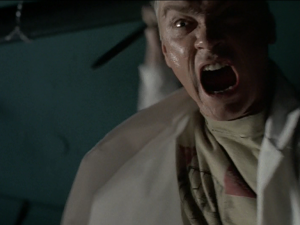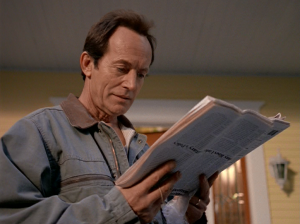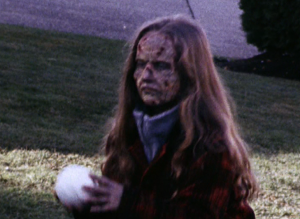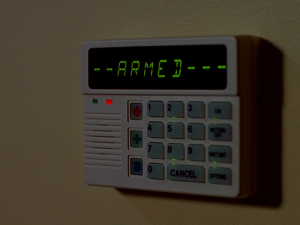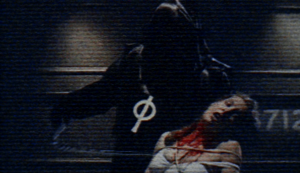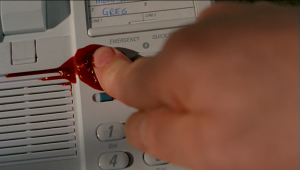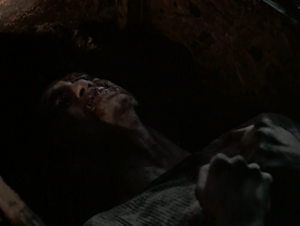With Halloween fast approaching and the announcement of a new IDW comic-book based on the beloved series, it seems an ideal time to remember Millennium, one of the creepiest and most imaginative horror programs in the medium’s history. The series celebrates its 18th anniversary on October 25th.
Millennium starred Lance Henriksen as ex-criminal profiler and family man Frank Black: a Seattle-based investigator looking into the human heart of darkness.
As the series commenced, Frank became a consult for the Millennium Group, a cadre of former law enforcement officials who were still in the game, and who sometimes seemed to have a shadowy agenda of their own. Frank was an especially valuable member of the team because of his insight, because he could see, essentially, what a killer sees, and more than that, decipher the imagery into meaningful patterns and clues.
While he attempted to keep the darkness of his work away from his family, including wife Catherine (Megan Gallagher) and daughter Jordan (Brittany Tiplady), Frank also investigated some of the most horrible crimes — and criminals — imaginable.
Although many stories featured a supernatural bent — including Darin Morgan’s “Somehow Satan Got Behind Me,” and the terrifying “Lamentation,” — Millennium’s bread-and-butter seemed to be human-based terror; or the terror that lurks within us, or in those of us who had been broken by the world.
So, excluding supernatural forces such as Sarah-Jane Redmond’s sinister and demonicLucy Butler, here are my selections for the five scariest episodes of Millennium:
“Weeds” (Written by Frank Spotnitz. Directed by: Michael Pattinson. Airdate: January 24, 1997)
In this unforgettable episode, an upper middle-class gated housing community in Pierce County, Washington is terrorized by a mad-man who paralyzes victims with a cattle prod and then forces them to drink his blood as an act of cleansing. After “healing” his victims in this fashion, the killer chops off their hands and murders them.
The idea underlining the episode is a terrifying one. The very steps we take to protect and isolate ourselves from the “evils” of the large world can, in fact, back fire. Gates, walls or bars may not keep evil out…they may just lock evil inside.
Those living in the exclusive community believe the fallacy that they can lock evil out, as well as one other: that those of a certain social class and benchmark of wealth must be “good” by nature. Now a serial killer — who sees all his victims as old and diseased — is cleansing the neighborhood of its “weeds,” making certain that the denizens live up to a self-righteous standard of perfection.
Like so many episodes of Millennium, “Weeds” suggests that danger in America lurks not outside our borders, not outside humanity, but in our very homes and hearths.
“Wide Open” (Written by Charles D. Holland. Directed by James Charleston. Airdate: January 3, 1997)
This story fits in very much with the paradigm we see in “Weeds.”
Here, in a chilling prologue, a serial killer sneaks into an upper middle-class home that is having a real estate open house. After the agent leaves for the day, the killer hides inside, undetected. Thus, when the family settles down for the night, activating its alarm system, the danger is already inside the house. The killer emerges by moonlight and kills everyone in the family (with an axe), save for Patricia, a little girl, whom the killer wants to force to re-experience the traumatic crime, again and again.
Once more, Millennium brings horror home to roost. Killers are not just lurking in our neighborhoods, behind the gates that are supposed to protect us, they are circumventing the security systems which afford us a (false?) sense of protection. This prologue captures, as well, the universal fear of returning home from a day away only to find a wolf hiding inside, ready to attack the sheep…
“The Mikado” (Written by: Michael Perry. Directed by: Roderick J. Pridy. Airdate: February 6, 1998)
In this horror story of the early Internet Age, Frank struggles to stop the serial killer operating a web site called “The Mystery Room,” where a twenty-six year old woman is bound to a chair. When the web site gets enough hits or clicks, the psycho will murder his victim.
Disturbingly, Frank realizes that the killer in this case may be “Avatar,” a serial killer who escaped justice in the early 1980s and has now re-emerged, having found his enthusiasm to kill re-kindled by the anonymity of the Internet.
The killer in this case is based on the real-life murderer, The Zodiac Killer, but even more compelling than that historical foot-note is the idea that murder has become a spectator sport and that, once freed from the responsibilities of identity, we — as Internet users — are tempted not only to see, but actually bring about the death of an innocent individual. Here, the audience becomes the killer, in a sense, by continuing to visit the web site, whether out of morbid curiosity, or worse, blood lust.
In “The Mikado,” Frank must not only catch a killer, he must race against that dark, societal impulse or blood-lust if he hopes to save the next victim. In true horror movie fashion, too, Avatar escapes, no doubt to re-emerge one day. Folks thinking of a Millennium feature film at this point may consider the return of Avatar — in the age of social media — the perfect standalone story.
“The Fourth Horseman” (Written by: Glen Morgan and James Wong. Directed by: Dwight Little. May 8, 1998)
In this episode of Millennium’s second season, Frank and Peter Watts (Terry O’Quinn) investigate the case of a man who has died of a fast acting and highly infection disease. A pathologist son realizes that Peter and Frank may have been exposed to this “Marburg Variant,” and Frank understands that the Group may be planning to release the disease into the general population in a planned Armageddon.
This episode is terrifying not only because of the threat of a pandemic, but because, again, Millennium brings horror right into America’s collective living room.
In this case, a middle-class family (again!) is sitting down to a Mother’s Day dinner. Chicken cooks on the grill in the back yard. The television is on, broadcasting a sporting event in the background. The family itself seems happy. But the chicken is contaminated, and as the family begins to eat, this fact becomes apparent. The mother grows ill first, and blood fountains out of her neck. Before long, she is literally sweating blood. Next, grotesque lesions form on the family members and they bleed out with shocking rapidity. One (disgusting) shot reveals the patriarch reaching for the phone to dial 911, but as his digit hits the phone, blood explodes forth from the flesh, and splatters it
Again, horror has come home.
“Pilot” (Written by Chris Carter. Directed by: David Nutter. Airdate: October 25, 1996)
The first episode of Millennium looks and sounds like a feature film, and remains one of the greatest series pilots in TV history.
In this episode we are introduced to Frank, his family, and his world. Here, Seattle is a place of incessant rain, and a killer — The Frenchman — moves anonymously through the city’s under-belly, murdering the sinful in an attempt to make Biblical prophecies of the End Times come to pass.
In one of the most gruesome scenes ever seen on network television, Frank attempts to rescue one of the Frenchman’s victims, a man who has been buried alive, and his eyes and mouth sewn shut. He screams (from sewn lips…) to be rescued from his premature grave.
As fearsome, perhaps, as this image remains, the “Pilot” remains so scary because it portends that much worse is coming. “The thousand years have begun,” says the Frenchman, meaning that Frank and his family must brace for a dark time. The dark is so pervasive, in fact, that it even affects Jordan, sending the family to the hospital when she develops a mysterious fever.
The pilot episode is beautifully photographed, and successfully contrasts the world of the deranged Frenchman with that of Frank Black, who has moved his family into an idyllic yellow house. The bright, sunshine yellow of that house is the inverse of the blood-stained walls that the Frenchman imagines in a sleazy peep-show.
The episode’s end is terrifying too. The darkness reaches Frank’s yellow house…by mail. He receives an envelope from an unknown stalker. Inside are photographs of his family in its new home. The darkness has found him again. And the idea of it invading, physically, his home, is roughly analogous to the impact of Frank’s “insights” (or visions) about the killers he hunts. Once they get into his mind, he can’t un-see them…they have invaded his mental home, so-to-speak.
The creepy thing about The Frenchman is that he understands this, and tells Frank that both men can see “the end coming.”
Would you like to support Flashbak?
Please consider making a donation to our site. We don't want to rely on ads to bring you the best of visual culture. You can also support us by signing up to our Mailing List. And you can also follow us on Facebook, Instagram and Twitter. For great art and culture delivered to your door, visit our shop.
